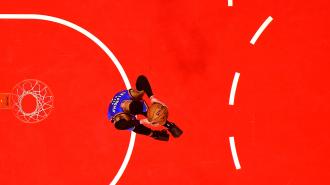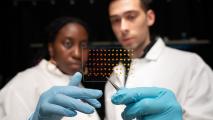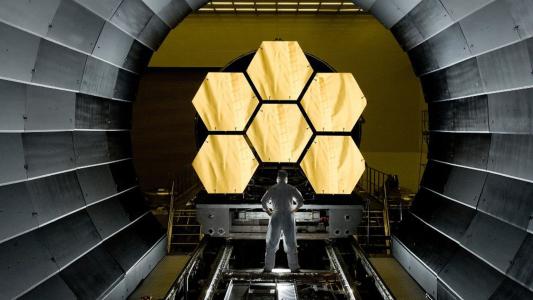In a fast-paced, high-scoring game like basketball, players have a lot of tasks on their plate. As they catch, pass, shoot, dribble, defend, and position themselves to help their teammates, they must constantly track the positions of both their teammates and opponents, while reacting to new situations within fractions of a second.
For individual players, such high-level tactics are only possible through close communication with their teammates: verbally, through eye contact and body language, and a lot of practice. With the average NBA team scoring a point every 25 seconds during a game, even the slight tactical improvements can make a difference to the outcome.
Yet with so many varying and unpredictable factors affecting the game, it is often difficult for teams to identify precisely how their strategies can improve.
Some help from physics: For Boris Barron at Cornell’s College of Arts and Sciences, this basic situation seemed familiar. Speaking at the American Physical Society Conference in Las Vegas in March 2023, the doctoral student presented an intriguing idea: that the positions of basketball players can be modeled in a similar way to systems of interacting quantum particles.
Entangled quantum particles behave in a strikingly similar way to the players on a basketball court, according to Boris Barron.
Barron’s idea stems from one of the key theories used by physicists to understand the influence of quantum entanglement: a mysterious phenomenon which emerges when particles like electrons, atoms, and ions are left to interact with each other.
When pairs of these quantum particles become entangled, the state of each partner can no longer be described independently. If anything happens to affect the state of one particle, this change will immediately be reflected in its partner, no matter how far apart they are separated in space.
Webs of communication: Through “density functional theory” (DFT), physicists study the influence of entanglement in systems containing many interacting quantum particles whose states can become deeply interconnected through intricate webs of entangled pairs.
Barron suggests that these systems behave in a strikingly similar way to the players on a basketball court, who constantly communicate with teammates across the court through shouts, nods, and glances.
Just as no particle in an entangled group can behave truly independently, no basketball player ever acts as an individual during a game: each player is constantly seeking out and responding to cues from their teammates, creating an intricate, dense web of communication that underlies the team’s overall performance.
The model could simulate how player positions could change to optimize the team’s performance.
Simulating team performance: To study this team behavior, Barron gathered detailed data on player positions from the 2022-23 NBA games. Using this information, he developed a new model of these team dynamics, based on physics models used to study groups of subatomic particles.
By plugging his model into simulated games, Barron could then make a variety of useful predictions, including where individual players will likely move next, which players tend to be in better or worse positions, and the probability that a given players’ move will have the desired result. Based on these calculations, the model could also simulate how player positions could change to optimize the team’s performance.
Compared with the moves of real NBA players, these simulated positions often only differed by a few feet – but altogether, Barron calculated that they could improve team performances by up to 3%: a crucial difference in a game famous for coming down to the wire.
Beyond basketball: Studying these simulations could add a new dimension to tactics and training for pro basketball players. But Barron also hopes that similar DFT-based models could apply equally well to other team sports where close communication between teammates is no less crucial.
The implications of this technique also stretch far beyond sports. Barron’s work is the latest application of an expansive area of research led by Cornell University’s Tomás Arias, who has pioneered the use of DFT to predict how large groups of people will behave.
Barron, Arias, and their colleagues are now using this approach to simulate scenarios ranging from crowds at festivals and political rallies, which can turn dangerous if not managed properly, to mass migrations following natural or manmade disasters, where well-informed humanitarian efforts have the potential to save thousands of lives.
We’d love to hear from you! If you have a comment about this article or if you have a tip for a future Freethink story, please email us at [email protected].






